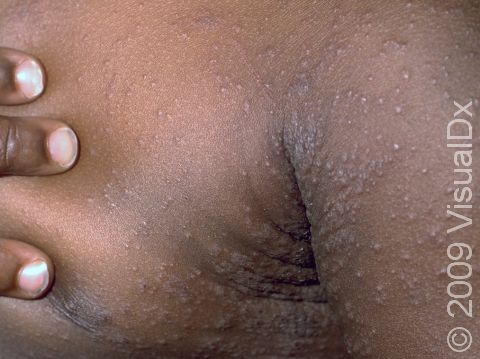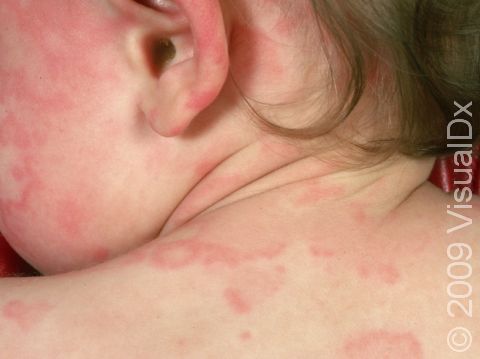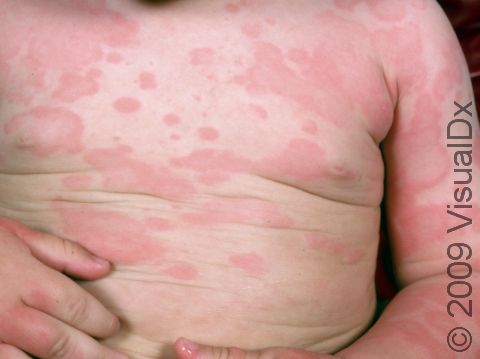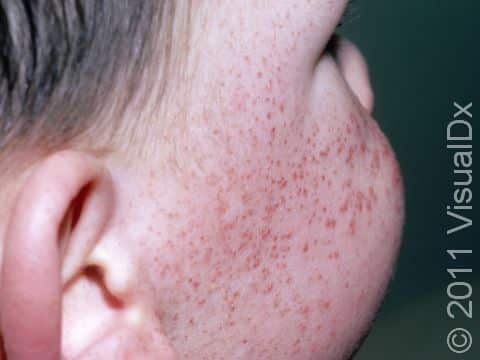Drug Eruption (Pediatric)
A drug eruption, also known as drug reaction or drug rash, is a skin condition caused by taking a medication, such a prescription medication or one bought over the counter. There are many types of drug eruptions, and any medication can cause a drug eruption. Typically, the drug eruption will occur 7-14 days after taking the medication.
Who's At Risk?
Although drug eruptions are more common in adults, they can occur in individuals of any age group, including children and babies.
People may be more likely to have a drug eruption if they:
- Have a weakened immune system due to illness or medication.
- Are taking more than 3 medicines daily.
Although any medication can cause a rash, the most common types of medications that cause a drug eruption include:
- Antibiotics such as penicillin or sulfa drugs.
- Anti-inflammatory medicines such as ibuprofen, naproxen, or indomethacin.
- Seizure medications (anticonvulsants) such as phenytoin or carbamazepine.
- Chemotherapy agents.
- Medicines for psychiatric illnesses (psychotropic medications).
- High blood pressure medications, such as diuretics and angiotensin-converting enzyme (ACE) inhibitors.
- Medication for gout (allopurinol).
- HIV medications.
- Iodine, especially that found in x-ray contrast dye.
Signs & Symptoms
Drug eruptions can appear as a variety of skin rashes, including pink-to-red papules (small, solid bumps), urticaria (hives), vesicles (small blisters), pustules (small pus-filled bumps), bullae (blisters larger than a thumbnail), or as sensitivity to sunlight. In darker skin colors, the redness may be harder to see. Drug eruptions may involve the entire skin’s surface, or they may be limited to one or a few body parts. Itching is common in many drug eruptions, and there may be a fever.
If your child has a fever, if their skin is tender, or if the inside of their mouth or genitals is involved, a more serious drug eruption may be present.
Self-Care Guidelines
For severe drug eruptions or drug eruptions that cover a large portion of the body, self-care is not recommended. Call your child’s medical professional or visit an urgent care, depending on how severe their symptoms are. If the child has skin pain or mouth or genital involvement, seek care immediately at an emergency room or call 911. If the child is having difficulty breathing, has a rapid heart rate, or their tongue, lips, throat, or face swell, seek emergency care or call 911.
For mild skin reactions affecting only small areas of the body, you could have your child:
- Take cool showers or baths or apply cool compresses.
- Apply calamine lotion to the rash.
- Take an antihistamine such as cetirizine (eg, Zyrtec) in children 6 months and older or diphenhydramine (eg, Benadryl) in children 2 years and older.
Do not have your child stop taking a prescription medication unless their medical professional advises you to do so.
Treatments
If the child’s medical professional suspects a drug eruption, they may want to establish the correct diagnosis by performing a biopsy of a lesion. Your child’s medical professional will help determine what medication changes are appropriate. After your child stops taking the medicine causing the drug eruption, it may take 5-10 days to see an improvement in the skin and up to 3 weeks for the rash to go away completely.
Other treatments the medical professional may recommend include:
- Oral antihistamine pills or syrups such as loratadine (eg, Children’s Claritin), cetirizine (eg, Children’s Zyrtec), fexofenadine (eg, Children’s Allegra), diphenhydramine (Children’s Benadryl), or hydroxyzine (eg, Vistaril) for itching.
- Topical corticosteroid (cortisone) creams or lotions to soothe red, inflamed skin.
- Topical antibiotic ointments to help heal open sores.
Visit Urgency
If your child started a new medication and developed a rash, you should immediately notify the prescriber.
Prepare a list of all the child’s medications, including prescription and over-the-counter pills or syrups, as well as topical creams, vitamins, and herbal or homeopathic remedies for the medical professional. Be sure to include medicines your child takes only occasionally. If possible, try to document when your child started taking each medication. Also note any previous reactions your child may have had to medicines or foods.
Trusted Links
References
Bolognia J, Schaffer JV, Cerroni L. Dermatology. 4th ed. Philadelphia, PA: Elsevier; 2018.
James WD, Elston D, Treat JR, Rosenbach MA. Andrew’s Diseases of the Skin. 13th ed. Philadelphia, PA: Elsevier; 2019.
Kang S, Amagai M, Bruckner AL, et al. Fitzpatrick’s Dermatology. 9th ed. New York, NY: McGraw-Hill Education; 2019.
Paller A, Mancini A. Paller and Mancini: Hurwitz Clinical Pediatric Dermatology. 6th ed. St. Louis, MO: Elsevier; 2022.
Last modified on July 11th, 2024 at 9:29 am

Not sure what to look for?
Try our new Rash and Skin Condition Finder



